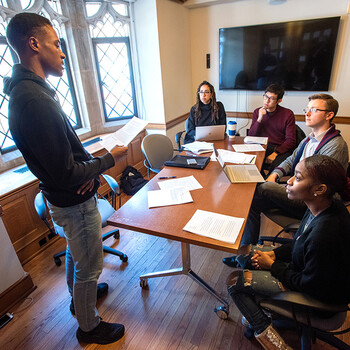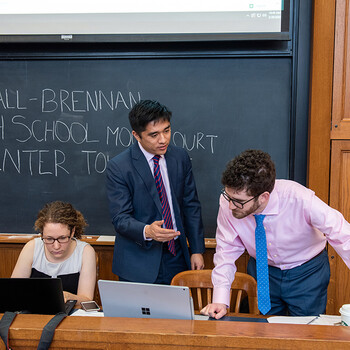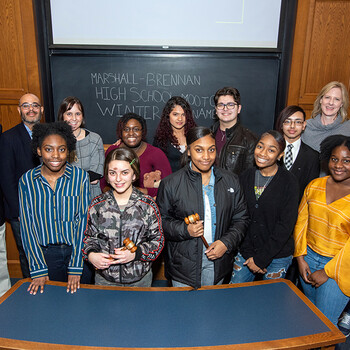Knowing Your Rights

When her name was announced as the winner of the Marshall-Brennan Constitutional Literacy Project’s Winter Moot Court Tournament, cheers erupted from Takeira Bell’s classmates in Room 127. After a full day of preliminary and semifinal rounds, she had won the tournament by arguing her side of a fictional Supreme Court case, the culmination of work done in three New Haven public schools as part of Yale Law School’s Marshall-Brennan Project.

Co-Op High School student Jontae McDonald argues his case in front of opponent India Kellman and three Yale Law School student judges
Bell, a student at New Haven’s Cooperative Arts and Humanities High School (Co-Op), was one of nearly 40 high school students who participated in the tournament, held at the Law School on February 28, 2020.
The Marshall-Brennan Project is part of a national civics education program that sends law students into New Haven public high schools to teach courses in constitutional law and oral advocacy. The program stands out by going beyond a typical civics course and increasing students’ awareness of their own constitutional rights.
Throughout the school year, students learn to argue both sides of the law and are encouraged to bring their stories into the classroom.
The program focuses on “the 21st century skills of creativity, problem solving, collaboration, and critical thinking — skills that are necessary to support an empowered, active, questioning democratic citizenry,” according to the national organization.
The moot court competitions with other local schools give students a chance to put these skills to the test and determine which teens will go on to compete at nationals.
Beyond the Civics Curriculum
Through the Marshall-Brennan program, participating Law School students had a unique opportunity to gain public school teaching experience, prepare high schoolers for oral argument through constitutional literacy, and connect with the New Haven community.
Law students ran all aspects of the program, from working closely with the classroom teacher on curriculum design and lesson planning to the actual classroom teaching. Classroom teachers also helped the law student teachers navigate the structure of the high schools and helped coordinate logistics for attending tournaments. In New Haven this year, six students taught in pairs at one of three public high schools: Co-Op, Hillhouse High School, and High School in the Community.
The school year began with studying the Fourth Amendment and its relevance to a school setting — issues like searches and seizures, mandatory drug testing, and locker searches. An examination of free speech rights under the First Amendment may involve what speech a school can regulate and when schools are able to regulate a student’s speech outside of the classroom. And a student’s Fifth Amendment Miranda rights would be implicated if, for example, a school official or police officer is interrogating them.
The high school students also trained in appellate advocacy and prepared for the moot court competition. The winter competition in February, the culmination of a major unit of the course, was a lively schoolwide affair, with morning preliminary rounds taking place in classrooms throughout the Law School.
Nearly 60 Law School students volunteered to serve as judges for the preliminary and semifinal rounds after completing a training session covering the details of the case and how to evaluate students’ performances fairly and consistently.

(from left) Becca Steinberg ’20, John Gonzalez ’20, and Timur Akman-Duffy ’21
The teens argued a fictional Supreme Court case in which a high school student was convicted of a misdemeanor cyberbullying charge based on his social media posts. After being charged and suspended from school, the student sued, arguing that his First and Fifth Amendment rights were violated. In the case, a U.S. District Court ruled in favor of the student, but an appeals court reversed the decision and the student was now seeking review in the U.S. Supreme Court.
The finals, between Bell and Gloriannis Vasquez from High School in the Community, were judged by Professor of Law Justin Driver, Leighton Homer Surbeck Professor of Law Cristina Rodríguez ’00, and Harvey Karp Visiting Lecturer in Law Stephen B. Bright. “The finalists were incredibly impressive in the face of some challenging questions that required them to think on their feet,” Driver said. “The judges did not hold back, and the students exceeded even our lofty expectations.”
In addition to the overall winners, prizes were given for Best Oralist and Best Legal Reasoning categories. A total of 13 students from New Haven were scheduled to compete at the Marshall-Brennan National High School Moot Court Competition in March at Rutgers Law School, but the competition had to be cancelled due to the coronavirus pandemic.
Last year, eight New Haven students went to the national tournament, and one finished as a semifinalist.
The pandemic brought other changes to the teaching program as well, with classroom teachers making adjustments based on what worked best in the context of their classroom, according to Steinberg.
“The students [were] all facing different circumstances, so we thought it was important to tailor the approach based on their needs and ability to be engaged right now,” she said. “Some of the classes [worked] on projects about famous court cases; others [worked] on doing oral arguments remotely through audio recording.”

Semifinalist Alissa Jones argues her case
For the Law School students who taught, the Marshall-Brennan program represented a large time commitment on top of their regular coursework.
“It’s a lot of time, you have around five hours in the classroom,” Gonzalez said. “You have prep. It’s early morning so there are some classes you can’t take.”
Steinberg and Gonzalez worked closely with Driver, who joined the Law School faculty from the University of Chicago Law School in fall 2019. They approached him about working with the Marshall- Brennan Project even before he arrived in New Haven. Driver, the author of an acclaimed book on students’ constitutional rights called The Schoolhouse Gate: Public Education, the Supreme Court, and the Battle for the American Mind, said he “leapt at the opportunity.”
“John came to me in the spring [of 2019] and showed me Professor Driver’s book, and it gives really good background to what’s going on in these cases,” Steinberg said. “So we reached out to him, and he was so receptive.”
Driver also teaches The Constitution Goes to School, a Law School course that examines how the Supreme Court’s constitutional opinions have shaped America’s public schools. Gonzalez and some of the law students teaching this year were enrolled in the class during the spring.
“John and Becca both demonstrate remarkable intellect, creativity, and commitment in their work with New Haven students, and working with the two of them has been a highlight of my first year at YLS,” Driver said.
An Opportunity to Teach
Some law students are drawn to the program through their previous teaching experience; Steinberg and Gonzalez both taught before law school in the Teach for America program. Peter Calello ’21 also taught before starting law school and was excited to get back in the classroom.
“Teaching Constitutional Law at High School in the Community has been one of the best experiences I have had at law school,” he said. “It has also been interesting seeing Constitutional Law through the lens of a high schooler. Having to explain case law and legal rules and applying rules to fact for high schoolers has definitely made me understand how law works better.”

Highschooler Manny Camacho (right) reviews his case with coach Timur Akman Duffy ’21
After he arrived in New Haven, Driver had the opportunity to witness three Law School students coaching high schoolers for the moot court competition.
“I found most impressive how the YLS students communicated high expectations, and how the oralists rose to meet the challenge,” Driver said. “Although they were only in high school, the students already evinced impressive understandings of complicated legal concepts involving students’ constitutional rights.”
In her class, Bianca Herlitz-Ferguson ’21 had students debate and practice writing and arguing constitutional cases. “The material is difficult, and the students never fail to impress me,” she said.
For the law student teachers, participation in the Marshall-Brennan Project has a meaningful impact not only on their own lives but also the way they approach law school and the profession.
“I have learned so much from my students about how they think about the law and the ways in which the law affects and regulates their lives,” Herlitz-Ferguson said. “Thinking through how the law uniquely applies to students and schools has also made me more interested in education law.”
A New Dimension
A new outgrowth of the Marshall-Brennan Project this year involved Steinberg and Gonzalez teaching an undergraduate course in Yale College through the Residential College Seminar Program, which offers unique courses within each of Yale’s undergraduate colleges outside of the traditional undergraduate curriculum.
As former Yale College students, Gonzalez and Steinberg noticed that there weren’t many opportunities to teach in a classroom as undergraduates.
“A lot of students in the college are going to teach after graduation, and they look at teaching from an academic perspective but not a concrete mechanics perspective,” Gonzalez said.
So the two created an undergraduate course, Teaching the Constitution, which aimed to reach Yale College students who were interested in both the law and teaching.
Drawing on the teaching material used in the Marshall-Brennan classrooms, Steinberg and Gonzalez’s syllabus was selected by a group of under- graduates for sponsorship in Pierson College. Eleven Yale College students took the seminar this year.
Gonzalez and Steinberg tied the undergraduate seminar back to the Marshall-Brennan program by having their undergraduate students do the types of oral argument and moot court simulations done in the high schools. Students in the seminar also practiced being teachers themselves, by visiting Marshall-Brennan high school classrooms with the freedom to design and deliver their own lessons. “It’s basically a law class and a teacher training class,” Gonzalez said.
Connecting with New Haven
Through the classroom teaching and moot court competition, and with the addition of this year’s undergraduate seminar, bridges were built between the New Haven high schools, Yale Law School, and Yale College communities. The three high schools are not far from the Law School, so the program was an opportunity for law students to get into the New Haven community and strengthen ties. Steinberg and Gonzalez said that the law school teachers put a lot of effort into building a positive culture and cohesive classroom environment for their students.

(left to right, back row) Stephen Bright, Justin Driver, Cristina Rodríguez, Takeira Bell, Marlen Pineda, Anthony Fiore, Manny Camacho, Heather Gerken, and Mahagany Rawls; (front row) Mellody Massaqoi, Gloriannis Vasquez, Alissa Jones, India Kellman, and Kayla Rountree
Usually during the year, Steinberg said, the students realized that their law school teachers were actually volunteers with a passion for civics, teaching, and creating a sense of community. “At some point… the high school students realize that the teachers don’t get paid to do this and they’re like, ‘What is going on? Why are you here every day if you’re not getting paid?’” she said.
Harry Murphy, a social studies teacher at Co-Op High School, has worked with student teachers from the Law School for five years. Generally, classroom teachers oversee the class and act as a certified teacher in the room. “Ultimately, as the teacher of record, the buck stops with me,” he said.
Over the course of the year, Murphy said he can see a huge transformation in his students.
“I see these kids start off refusing to talk in class, and then by [the moot court competition], they are literally arguing cases and citing the appropriate law,” he said. “They get and understand nuance, which many adults don’t.”
For Murphy, watching students experience the program can be memorable. At nationals in Boston one year, a former student made it to the finals. “As the two students argued their cases in front of the panel of real judges, I was so sure Ashley had lost. The other student argued like a scene out of Law and Order,” he said.
But Ashley remained calm during her argument, and prevailed. “When she won, I was shocked,” Murphy said. “But the lead judge made a point that it’s not the theatrics in a moot court competition, it’s the well thought out and argued case!”
Steinberg and Gonzalez are excited to see the continued development of the Marshall-Brennan Project after they graduate. Next year, the program will be directed by Felisha Miles ’21 and Timur Akman-Duffy ’21, who taught at Hillhouse this year.
“I think the program has really grown over the last three years as we’ve gotten more recognition both from the University and also from the student body and from New Haven schools,” Gonzalez said. “That’s really cool to see.”
“It really is remarkable to see how far they come in just a short amount of time,” Murphy said. “When you see them stand up and answer some tough questions, you see their confidence. It is amazing.”


